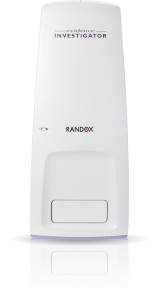Update on Sample Kits

STATEMENT FROM RANDOX: 07 August 2020
Randox Laboratories have today taken the decision to recall Covid-19 sample collection kits, following the identification of incomplete EC certification. On 15th July DHSC placed these kits on hold due to the absence of swab certification from an external supplier. To date, Randox have not been provided with evidence to satisfactorily support the CE marking for these swabs. So, noting the lack of CE certification by the supplier and that some kits remain in the field at this time Randox has, as a regulatory measure, initiated the recall of those kits used within the National Testing Programme.
Randox Laboratories will continue to provide high volume Covid-19 testing to the National Testing Programme from their laboratories, based on sample collection kits from other providers.
DHSC have stated the risk to safety is low and test results from Randox kits are not affected.
This recall applies only to sample collection kits within the UK National Test and Trace Programme. Randox private customers or kits are not affected.
Press enquiries should be emailed to randox@newcenturymedia.co.uk
Randox in the media
Latest News
FAQs
Bilirubin
Bilirubin
A Marker of Hepatic Dysfunction
Benefits of the Randox Bilirubin Assay

Excellent correlation
The Randox bilirubin assay has a correlation coefficient > 0.99% CV when compared to commercially available methods.

Direct & Total assays available
Randox offer both direct & total bilirubin assays offering choice and flexibility.

Liquid ready-to-use
The Randox bilirubin assay is available in a liquid ready-to-use format for convenience and ease-of-use.

Calibrator and dedicated control available
Calibrator and dedicated control available offering a complete testing package.

Applications available
Applications available detailing instrument-specific settings for the convenient use of the Randox bilirubin assay on a variety of clinical chemistry analysers.
Direct
| Cat No | Size | Method | ||||
|---|---|---|---|---|---|---|
| BR123456 | 2 x 250 (L) | Modified Jendrassik | Enquire | Kit Insert Request | MSDS | Buy Online |
| BR3807 | R1 2 x 30ml (L) R2 8 x 4ml | Jendrassik | Enquire | Kit Insert Request | MSDS | Buy Online |
| (L) Indicates liquid option | ||||||
Total
| Cat No | Size | Method | ||||
|---|---|---|---|---|---|---|
| BR2361 | 2 x 250ml (L) | Modified Jendrassik | Enquire | Kit Insert Request | MSDS | Buy Online |
| BR3859 | R1 2 x 50ml (L) R2 8 x 4ml | Jendrassik | Enquire | Kit Insert Request | MSDS | Buy Online |
| (L) Indicates liquid option | ||||||
Direct & Total
| Cat No | Size | Method | ||||
|---|---|---|---|---|---|---|
| BR411 | R1. 1 x 50ml (L) R2. 1 x 10ml R3. 1 x 100ml R4. 1 x 100ml | Jendrassik | Enquire | Kit Insert Request | MSDS | Buy Online |
Instrument Specific Applications (ISA’s) are available for a wide range of biochemistry analysers. Contact us to enquire about your specific analyser.
Bilirubin is a metabolite of haem, derived from haem-containing proteins, including myoglobin, haemoglobin and various P450 enzymes, that serves to coordinate iron in various proteins. Half of it is excreted into bile and the rest contributes to blood bilirubin turnover 1. It is mainly produced in the spleen and liver but can also occur elsewhere in the body by macrophages and renal tubular cells 2. The internal hydrogen bonding causes it to be water-insoluble and so required enzyme-mediated glucuronidation in the liver for biliary excretion. Under normal conditions, it is mostly unconjugated and bound tightly to albumin 3.
Bilirubin is one of the most common diagnostic tests utilised in the diagnosis and monitoring of hepatic dysfunction. It is impaired in cholestatic and parenchymal liver diseases. The most common condition associated with elevated levels is jaundice (a clinical sign of hyperbilirubinaemia), characterised by the yellow colouring of skin, mucous membranes and sclera 3.
Today, it is recognised as being more than just an end-product and considered to be a fundamental substance. Bilirubin is recognised as acting as an antioxidant and anti-inflammatory agent in serum. Evidence exists that states that it can neutralise free radicals, prevent peroxidation of lipids and protects the cardiovascular system, hepatobiliary system, immune system, neuronal system and pulmonary system 4.
It has been established that bilirubin levels are significantly elevated in COVID-19 patients 5. Patients with abnormal liver function tests were at a significantly higher risk of progressing to a severe disease, such as pneumonia. The presence of abnormal liver function tests became more pronounced during hospitalisation within two weeks, with total bilirubin levels elevated 3 times the upper normal limit 6.
Related Products
Clinical Chemistry Calibrator
Bilirubin Elevated Control
Reagents Homepage
References
[2] Leach T. Bilirubin Metabolism and Jaundice. https://almostadoctor.co.uk/encyclopedia/bilirubin-metabolism-and-jaundice (accessed 10 March 2020).
Vivalytic | Viral Respiratory Infection Array

Vivalytic | 10-Plex Viral Respiratory Infection Array
–
Detect 10 viral respiratory infections in 2 hours 30 minutes
Research Use Only
Detecting SARS-CoV-2 (COVID-19)
Clinical Significance
The Viral Respiratory Tract Infections (VRI) test offers a rapid and comprehensive solution, capable of detecting 10 different viral respiratory infections, including SARS-CoV-2, within a remarkably short timeframe of 2 hours and 30 minutes.
This extensive panel equips healthcare providers with the ability to swiftly identify potential co-infections, thereby enabling them to make more informed treatment decisions for patients grappling with respiratory illnesses. The expedited detection of multiple viruses not only aids in timely intervention but also holds the promise of reducing unnecessary antibiotic usage, consequently leading to improved patient outcomes and more effective management of respiratory conditions.
Features
Sample Type: Nasopharyngeal or Oropharyngeal Swab (eNAT)
Sample Volume: 300 μl
Detection Method: Randox Biochip Technology (end-point PCR)
Time to result: 2 hours 30 minutes
| Detectable Viruses | ||
|---|---|---|
| SARS-CoV-2 (COVID-19) | Sarbecovirus (SARS, SARS like, SARS-CoV-2) | Influenza A |
| Coronavirus 229E/NL63 | Adenovirus A/B/C/D/E | Influenza B |
| Coronavirus OC43/HKUI | Enterovirus A/B/C/D / Rhinovirus A/B/C | Respiratory Syncytial Virus A/B (RSV) |
| Middle East Respiratory Syndrome Coronavirus (MERS-CoV) | Adenovirus A/B/C/D/E | |
“AWARD-WINNING DESIGN DELIVERS
AN UNCOMPLICATED USER EXPERIENCE”
Vivalytic Workflow
Intuitive engineering of Vivalytic ensures the analyser is user friendly. The process of patient sample to result comprises a very simple 4 step workflow.
To begin the test, the user scans or enters sample information. The cartridge code is then scanned into the embedded Vivalytic software. The user then adds sample into the dedicated cartridge slot, closes the lid and inserts the cartridge into the Vivalytic.
The touchscreen display will countdown the time remaining to test completion. Results will be displayed on the screen. Multiple Vivalytics can be wirelessly connected allowing the user to control multiple tests at one time all reporting to a master Vivalytic platform.
Want to know more?
Contact us or visit our COVID-19 Monitoring & Management page
Related Products
SARS-CoV-2 Rapid Test
SARS-CoV-2 Pooling Test
Vivalytic
Vivalytic Test Menu
Enzymatic Creatinine Assay
Reagent | Creatinine (Enzymatic)
A Highly Sensitive And Reproducible Method
Benefits of the Randox Enzymatic Creatine Assay
Superior method
The Randox enzymatic method offers a superior specificity when compared to the traditional Jaffe method.
Excellent precision
The Randox creatinine assay displayed a within run precision of < 2.18% CV.
Exceptional correlation
The Randox enzymatic creatinine assay displayed a correlation coefficient of at least r=0.99 when compared to commercially available methods.
Limited interferences
The Randox enzymatic creatinine assay suffers minimal interferences from Bilirubin, Haemoglobin, Intralipid® and Triglycerides, for truly accurate results and ensures suitability with paediatric samples.
Calibrator and controls available
Calibrator and controls available offering a complete testing package.
Applications available
Applications available detailing instrument-specific settings for the convenient use of the Randox enzymatic creatinine assay on a variety of clinical chemistry analysers.
Ordering Information
| Cat No | Size | ||||
|---|---|---|---|---|---|
| CR2336 | R1 4 x 50ml (S) R2 4 x 10ml | Enquire | Kit Insert Request | MSDS | Buy Online |
| CR2337 | R1 4 x 100ml (S) R2 4 x 20ml | Enquire | Kit Insert Request | MSDS | Buy Online |
| CR4037 | R1 4 x 50ml (L) R2 4 x 19.5ml | Enquire | Kit Insert Request | MSDS | Buy Online |
| CR8122 | R1 4 x 65ml (L) R2 4 x 32.3ml | Enquire | Kit Insert Request | MSDS | Buy Online |
| CR8317 | R1 4 x 20ml (L) R2 4 x 9.5ml | Enquire | Kit Insert Request | MSDS | Buy Online |
| (L) Indicates liquid option (S) Indicates standard included in kit |
|||||
Instrument Specific Applications (ISA’s) are available for a wide range of biochemistry analysers. Contact us to enquire about your specific analyser.
More Information
The Laboratory Working Group of the National Kidney Disease Education Program (NKDEP) released guidelines for the improvement of glomerular filtration rate (GFR) estimation as well as the measurement of serum creatinine (SCr). The recommendation included the recalibration and standardisation of SCr methods to be traceable to the isotope dilution-mass spectrometry (IDMS) reference method. Two IDMS traceable creatinine methods are commercially available: enzymatic assays and compensated Jaffe assays 1.
Of the two enzymatic assays available, the Randox enzymatic creatinine assay converts creatinine to ammonia (NH3) and I-Methylhydantoin. Ammonia then reacts with α-oxoglutarate in the presence of GLDH with oxidation of the co-enzyme NADPH. The decrease of NADPH is proportional to the creatinine concentration and is measured at 340nm 1, 2.
The Randox enzymatic creatinine assay exhibits high sensitivity and reproducibility with the added advantage of liquid ready-to-use reagents with good stability. The enzymatic method represents an improvement for use in the accurate and reliable determination of creatinine.
Creatinine is the end-product of muscle catabolism of creatine. In humans, creatinine production is relatively stable, but mainly depends on muscles mass. Consequently, any physiological changes in muscle mass will cause a variation in the creatinine pool independently of GFR changes. Creatinine is freely filtered by the glomerulus at a constant rate with 10% to 40% secreted by the tubules 1.
According to the National Institutes of health, the overall prevalence of chronic kidney disease (CKD) is approximately 14% 3. Creatinine is the most commonly utilised assay in the assessment of renal function 4. The National Kidney Disease Education Program recommends calculating GFR from SCr. Creatinine measurements are useful in the monitoring of disease progression, with the diagnosis of renal failure when SCr levels are greater than the upper normal interval 5.
Creatinine measurements are useful in the diagnosis and monitoring of diabetic nephropathy, the leading cause of kidney disease in patients commencing renal replacement therapy, affecting 40% of diabetics (type 1 and type 2) 6. The RENAAL risk score for end-stage renal disease (ESRD) emphasizes the importance of the identification of elevated SCr, alongside other renal markers, in the prediction of end-stage renal disease (ESRD) development in patients with type 2 diabetes mellitus (T2DM) and nephropathy 7.
Acute kidney injury (AKI) is a common complication in COVID-19 patients 8. The analysis of creatinine in COVID-19 patients on hospital admission and after 2 to 4 days highlighted impaired renal function and is the leading cause of death in these patients 9. The National Institute of Care Excellence (NICE), have set out four guidelines for acute kidney injury in hospitalised suspected or confirmed COVID-19 patients and highlights the importance of creatinine testing 10.
Related Products
Clinical Chemistry Calibrator
Clinical Chemistry Controls
Clinical Chemistry EQA
References
[2] Randox Laboratories. Creatinine (Enzymatic UV) CR2336. 2020
[3] Gounden V, Bhatt H, Jialal I. Renal Function Tests. Treasure Island: StatPearls Publishing; 2020. https://www.ncbi.nlm.nih.gov/books/NBK507821/ (accessed 24 July 2020).
[7] Dabla PK. Renal function in diabetic nephropathy. World Journal of Diabetes 2010; 1(2): 48-56.
[8] Mahmoudi H, Alikhani MY, Taheri NM, Behzadi A. Assessment of changes in blood urea and creatinine levels in patients with coronavirus disease 2019 (COVID-19). v 2020: https://www.researchsquare.com/article/rs-25164/v1 (accessed 16 July 2020)
[10] National Institute of Care Excellence (NICE). COVID-19 rapid guideline: acute kidney injury in hospital. https://www.nice.org.uk/guidance/ng175/chapter/4-Assessing-for-AKI-in-patients-with-suspected-or-confirmed- COVID-19 (accessed 16 July 2020).
COVID-19 Testing Service Testimonial: The Irish Football Association
COVID-19 Testing Service Testimonial: The Irish Football Association
As we move towards a new ‘normal’ and sporting organisations begin the process of restarting their games, many teams will be wondering how to ensure a safe and reassuring training environment for their players and their staff.
Thanks to our COVID-19 testing service, The Irish Football Association was able to facilitate a timely and efficient return to play by confirming their players as ‘COVID-safe.’
Our ‘Back to Business’ programme has enabled the IFA to demonstrate their commitment to their players, their staff, and their fans, as well as get back to business by ensuring the highest level of safety.
Corinne Lannie, Risk Manager at the Irish Football Association, commented;
“The test kits were very straightforward to use. The instructions were clear as was the YouTube guidance video. The recording onto the Randox system was easy and the speed of results was exceptional.
“The support provided by Paul (Randox Business Development Executive) was amazing – he was extremely helpful and supportive and really went above and beyond.”
At Randox, we offer two types of testing;
PCR (diagnostic) testing, and antibody testing, which can give an indication that an individual has been previously infected with COVID-19.
Sample collection services are available.
David Hallendorff, Business Relations Manager at Randox Health commented;
“Collectively we are all working towards a timely return to a more normal society, which will see companies reopening and people returning to work.
“To facilitate this recovery of the economy, without compromising the health of workers or of the wider general public, workplaces have a responsibility to provide a safe working environment.
“It is great to see so many companies putting the health of their staff as a priority and taking a proactive approach to testing.”
To find out more about our Back to Business COVID-19 Testing Service, please email info@randoxhealth.com or phone 0800 2545 130
Want to find out more?
Click one of the links below.
COVID-19 Products and Services
HOME TEST
ANTIBODY TEST
TESTING SERVICE
LABORATORY TOOLS
COVID-19 Cytokine Testing Solutions
COVID-19 Risk Stratification and Treatment Monitoring
Randox offer testing solutions for a comprehensive range of cytokines, cytokine receptors and growth factors designed to assist with COVID-19 risk stratification, monitoring of treatment efficacy and recovery. Utilising patented Biochip technology up to 12 cytokines and growth factors may be detected simultaneously from a single patient sample.
Cytokines play a vital role in the immune system and are known to be involved in the body’s response to a variety of inflammatory and infectious diseases. The over stimulation of these cytokines in response to infection is referred to as a ‘cytokine storm’ and strongly correlates with poor disease outcomes.
Cytokine storms are a common complication of SARS-CoV-2 (COVID-19) infection triggering viral sepsis, where viral replication and excessive, uncontrolled systemic inflammation may lead to pneumonitis, Acute Respiratory Distress Syndrome (ARDS), respiratory failure, shock, multiple organ failure, secondary bacterial pneumonia, and potentially death.

Cytokine Array I (12-plex)
Interleukin-1 (IL-1) is a regulatory and inflammatory cytokine, which exists in two forms, (IL-1α) and (IL-1β), which share 25% homology at amino acid level. IL-1α is produced as a biologically active 31 kDa precursor, which undergoes proteolytic cleavage yielding a 17 kDa protein of 159 amino acids.
There are two forms of IL-1, IL-1α and IL-1β ,which share 25% homology at amino acid level. IL-1β is synthesised as a biologically inactive precursor of 269 amino acids with a molecular mass of 31 kDa , which undergoes proteolytic cleavage by IL1 converting enzyme (ICE), which yields a 17kDa protein of 153 amino acids.
Interleukin-2 (IL-2) is an interleukin, a type of cytokine signaling molecule in the immune system. It is a 15 – 18 kDa protein which has varying degrees of glycosylation accounting for the observed molecular weight range. IL-2 regulates the activities of white blood cells (leukocytes, often lymphocytes) that are responsible for immunity.
IL-4 is a glycoprotein synthesised as a precursor protein of 153 amino acids. The first 24 amino acid residue signal peptide is cleaved to produce a 129 amino acid 15-19 kDa protein.
IL-6 is synthesised as a precursor protein of 212 amino acids. The N-terminal 28 amino acid residue signal peptide is cleaved to produce a 21kDa protein. It has two potential N-glycosylation sites which have no effect on bioactivity. Different post-translational alterations such as glycosylation and phosphorylation give various forms of IL-6 with molecular masses of 21.5-28 kDa. The IL-6 receptor is a strongly glycosylated 80 kDa protein of 449 amino acids. Two different forms of the receptor have been described that bind IL-6 with differing affinities, a soluble form of the IL-6 receptor has also been described. The IL-6 receptor is expressed on T cells, mitogen activated B cells, peripheral monocytes and some macrophage and B cell derived tumour cell types. IL-6 also influences antigen-specific immune responses and inflammatory reactions.
IL-8 is a member of a structurally similar family of cytokines called chemokines, which demonstrate chemotactic activity for neutrophils. IL-8 is a non-glycosylated protein of 8 kDa and consists of 99 amino acids with a 22 residue signal peptide that is cleaved to generate a 77 amino acid sequence. IL-8 is produced in response to proinflammatory stimuli. It is produced by monocytes, macrophages, fibroblasts, endothelial cells, keratinocytes, melanocytes, hepatocytes, chondrocytes, T-cells, neutrophils, and astrocytes.
Interleukin-10 (IL-10), alternatively known as B-cell-derived T-cell growth factor (B-TCGF), cytokine synthesis inhibitory factor (CSIF) or T-cell growth inhibitory factor is a homodimeric protein with a molecular weight of 18 kDa. It is produced as a 178 amino acid residue precursor, which is cleaved to give a mature protein of 160 amino acids. IL-10’s primary function is as an anti-inflammatory agent, which inhibits cytokine production by T cells and natural killer cells caused by activation of monocytes/macrophages.
IFN-γ is a cytokine critical to both innate and adaptive immunity, and functions as the primary activator of macrophages, in addition to stimulating natural killer cells and neutrophils. Biologically active interferon gamma is a 20 or 25 kDa glycoprotein depending on its glycosylation state. This lymphokine is synthesised as a 166 amino acid sequence but is cleaved to give a 143 amino acid residue.
Human EGF is produced as a long precursor protein of 1207 amino acids which is released by proteolytic cleavage to give a globular protein of 6.4 kDa consisting of 53 amino acids. EGF is a common mitogenic factor that stimulates the proliferation of different types of cells, especially fibroblasts and epithelial cells. EGF activates the EGF receptor (EGFR/ErbB), which initiates, in turn, intracellular signaling.
Monocyte chemoattractant protein (MCP-1) is part of the chemotactic family of cytokines called chemokines. ). It is a 76 amino acid peptide and has a molecular weight of 8.6 kDa. MCP-1 in particular chondrocytes confirming its role in inflammatory responses. MCP-1 has been implicated in a wide variety of inflammatory diseases such as artherosclerosis, delayed hypersensitivity reactions, rheumatoid arthritis, alveotitis and idiopathic pulmonary fibrosis.
Tumour necrosis factor alpha (TNFα) is a 157 amino acid 26 kDa transmembrane protein which is secreted as a soluble mature 233 amino acid homotrimer of 17 kDa by proteolytic cleavage. TNF-α is secreted by macrophages in response to stimuli for the induction of systemic inflammation. The binding of the ligand TNF-α to the TNF receptor (TNFR1) initiates the pro-inflammatory and pro-apoptotic signaling cascades.
Vascular endothelial growth factor (VEGF), also known as vascular permeability factor (VPF), is secreted as a glycosylated homodimeric protein of 46 kDa that is made up of two 24 kDa subunits linked by disulphide bonds. VEGF is expressed by vascularised tissue such as pituitary, brain, lungs, kidneys, heart and adrenal glands, although it is assumed that all tissues have the potential to produce the growth factor. VEGF is stimulated when cells become deficient in oxygen or glucose or under inflammatory conditions.
Ordering Information
| Cat. Number | Description | Kit Size |
|---|---|---|
| EV3508 | Cytokine Array I Evidence | 360 Biochips |
| EV3544 | Cytokine Array I Evidence | 180 Biochips |
| EV3513 | Cytokine Array I Evidence Investigator | 54 Biochips |
| EV3623 | Cytokine Array I High Sensitivity Evidence Investigator | 54 Biochips |
Cytokine Array III (4-plex)
Interleukin-5 (IL-5) is a disulphide linked homodimer and belongs to a family of structurally related proteins that includes: interleukin-2, interleukin-4, macrophage colony-stimulating factor, granulocyte macrophage colony-stimulating factor and growth hormone. It is a glycoprotein with the apparent molecular weight of recombinant IL-5 produced by mammalian cells in the range 45 to 60 kDa. The large variation in the molecular weight caused predominantly by the addition of heterogeneous carbohydrate chains.
Interleukin-15 (IL-15) is a 14 to 15 kDa protein of 114 amino acids. It contains 2 disulphide bonds and 2 N-linked glycosylation sites at the C-terminus1. IL-15 is expressed at the mRNA level in numerous normal human tissues in a broad range of cell types, including activated monocytes, dendritic cells, osteoclasts and fibroblasts. IL-15 has an essential role in natural killer (NK) cell development. It activates NK cell proliferation, cytotoxicity, and cytokine production and regulates NK cell/macrophage interaction. Studies have suggested that IL-15 may have a role in establishing innate immune responses and maintaining neutrophil-mediated inflammatory processes.
Granulocyte-macrophage colony stimulating factor (GMCSF) isolated from human sources is glycosylated with an apparent molecular mass of 23 kDa. The mature protein has 127 amino acids and is preceded by a hydrophobic leader sequence of 25 amino acids.
Macrophage inflammatory protein-1α (MIP-1α, CCL3) is a member of the CC chemokine subfamily whose members are known for chemotactic and proinflammatory effects and also for the promotion of homeostasis. MIP-1α is synthesised as a 92 amino acid precursor that is proteolytically processed to a mature protein of about 70 amino acids. MIP-1α has roles in inflammatory responses at sites of injury or infection by recruiting proinflammatory cells.
Ordering Information
| Cat. Number | Description | Kit Size |
|---|---|---|
| EV3680 | Cytokine Array III Evidence | 180 Biochips |
| EV3678 | Cytokine Array III Evidence Investigator | 54 Biochips |
Cytokine Array IV (5-plex)
Matrix metalloproteinase-9 (MMP-9) (gelatinase B) (92 kDa) is a member of the matrix metalloproteinase (MMP) family. MMP-9, one of the most widely investigated MMPs, regulates pathological remodeling processes that involve inflammation and fibrosis.
Soluble IL-2 receptor α (sIL-2Rα) results from the proteolytic cleavage of IL-2Rα at the cell surface by a membrane metalloproteinase; which is encoded by IL2RA on human chromosome. It’s widely noted in research that sIL-2Rα has been found in diseases caused by infections, autoimmune disease and organ transplantation.
Interleukin-6 (IL-6) is a multifunctional cytokine that regulates pleiotropic roles in immune regulation, inflammation, hematopoiesis, and oncogenesis. The IL-6 receptor complex belongs to the haematopoietic receptor superfamily and mediates the biological activities of IL-6. It consists of two distinct membrane bound glycoproteins, an 80 kDa cognate receptor subunit (IL-6R) and a 130 kDa signal-transducing element (gp130). The gp130 subunit is expressed in almost all organs including heart, kidney, spleen, liver, lung, placenta and brain.
Tumour necrosis factor receptor I is one of two specific, high affinity cell surface receptors that function as transducing elements, providing the intracellular signal for cell responses to tumour necrosis factor (TNF). TNF is a proinflammatory cytokine mainly produced by stimulated monocytes, macrophages and T-lymphocyte subsets. It has a key role in host defence and immunosurveillance, mediating complex cellular responses of a different, even contrasting nature. TNFRI has a molecular mass of 55 kDa1 and is expressed by almost all cell types2 especially those cells that are susceptible to the cytotoxic action of TNFI. TNFRs are detectable in normal serum, but their concentration increases significantly in inflammatory and non-inflammatory diseases.
Tumour necrosis factor receptor II (TNFRII) is one of two specific, high affinity cell surface receptors that function as transducing elements, providing the intracellular signal for cell responses to tumour necrosis factor (TNF). TNF is a proinflammatory cytokine mainly produced by stimulated monocytes, macrophages and T-lymphocyte subsets. It has a key role in host defence and immunosurveillance, mediating complex cellular responses of a different, even contrasting nature. TNFRII has a molecular mass of 75 kDa1. Although TNFRII is expressed by almost all cell types, it is expressed primarily by cells of the immune system, cells of myeloid origin and endothelial cells.
Ordering Information
| Cat. Number | Description | Kit Size |
|---|---|---|
| EV3659 | Cytokine Array IV Evidence | 180 Biochips |
| EV3661 | Cytokine Array IV Evidence Investigator | 54 Biochips |
Cytokine Array V (5-plex)
Interleukin-3 (IL-3) possesses diverse biological activities and was discovered independently in studies on its biological activities. IL-3 is a heavily glycosylated protein with a polypeptide chain of 133 amino acids. It occurs naturally in a diversity of glycoforms generated by the addition of carbohydrate groups which results in size heterogeneity from 28 to 45 kDa. The function of the extensive carbohydrate modifications of the IL-3 polypeptide is not known however IL-3 has been linked with various diseases including colorectal and pancreatic cancers.
Interleukin-7 (IL-7) is classified as a type 1 short-chain cytokine of the haematopoietin family, a group that also includes IL-2, IL-3, IL-4, IL-5, GM-CSF, IL-9, IL-13, IL-15, M-CSF, and stem cell factor. The human gene for IL-7 is located on chromosome 8q12-13. The amino acid sequence of IL-7 predicts a molecular weight of 17.4 kDa, but glycosylation results in an active protein of 25 kDa. IL-7 appears to be involved in the development of an effective immune system and also in the generation and maintenance of strong and effective cellular immune responses directed against cancer cells, or infectious diseases.
Interleukin-12 (IL-12) is a 75 kDa heterodimeric glycoprotein cytokine composed of disulphide linked p40 (40 kDa) and p35 (35 kDa) subunits that are derived from separate genes1. p35 is expressed in a limiting and tightly regulated fashion by many different cell types, however the expression of p40, though in greater quantities than required for p70 formation, appears to be restricted to antigen presenting cells. IL-12 stimulates IFN production, which is essential in resistance to intracellular protozoan, fungal and bacterial infections and, in addition, tumours. Traditionally, IL-12 is accepted as an important mediator of autoimmunity and is involved in a number of autoimmune diseases including rheumatoid arthritis, psoriasis, inflammatory bowel disease and insulin-dependent diabetes mellitus.
Interleukin-13 (IL-13) is a 12 kDa protein that folds into four I-helical bundles. It contains four potential N-glycosylation sites and four cysteine residues that form two intramolecular disulphide bonds. IL-13 shares a number of structural features and functional characteristics with IL-4. The IL-13 protein is approximately 25% homologous1 with IL-4 and belongs to the same I-helix protein family. IL-13 plays a dominant role in resistance to most gastrointestinal nematodes and also modulates resistance to intracellular organisms by regulating cell mediated immunity. IL-13 is the central mediator of allergic asthma, where it regulates eosinophilic inflammation, mucus secretion, and airway hyperresponsiveness. Although IL-13 is associated primarily with the induction of airway disease, it also has anti-inflammatory properties.
Interleukin 23 (IL-23) is member of the IL-12 family. The IL-12 family consists of cytokines IL-12(p40p35), IL-23(p40p19) and IL-27(EBI13p28), and monomeric and homodimeric p401. IL-23 is a heterodimeric cytokine composed of disulphide linked p19 and p40 subunits. IL-23 plays a role in a signaling pathway that triggers inflammation.
Ordering Information
| Cat. Number | Description | Kit Size |
|---|---|---|
| EV3666 | Cytokine Array V Evidence Investigator | 54 Biochips |
Immunoassay Platforms
Want to know more?
Contact us or visit our COVID-19 Monitoring & Management page
Related Products
Cytokine Array I Control
Cytokine Array I High Sensitivity Control
Cytokine Array III Control
Cytokine Array IV Control
Temporary Precautionary Measure

STATEMENT FROM RANDOX: TEMPORARY PRECAUTIONARY MEASURE
16 July 2020
As an immediate precautionary measure we have temporarily suspended distribution of sample collection kits using one particular batch / supplier of swabs. This is a temporary measure and does not apply to our private business which uses a different supplier of swabs.
Test results from Randox kits are not affected.
For more information please contact the Randox PR team by emailing randoxpr@randox.com
Randox in the media
Latest News
FAQs
Early Detection of Acute Kidney Injury in COVID-19 patients
15 July 2020
The Importance of Early Detection of Acute Kidney Injury in COVID-19 patients
Randox are proud to provide an early detection assay, capable of detecting Acute Kidney Injury in COVID-19 positive patients. AKI is an innovative diagnostic tool with the ability to identify four early and highly sensitive markers of kidney injury.
The National Institute for Health and Care Excellence has highlighted that is important that COVID-19 patients are assessed for AKI on admission to hospital or transfer, monitored for AKI throughout their stay and that AKI is managed appropriately if it develops. (NICE, 2020)
The novel test, which includes biomarkers recommended by the U.S. Food and Drug Administration and the European Medicines Agency detects KIM-I, NGAL, Cystatin C, and Clusterin.
Kidney failure associated with COVID-19 is emerging as a common side effect with further studies underway. Early detection to prevent further renal damage, is vital for an individual’s long-term health, wellbeing and overall survival.
The biomarkers on the Randox AKI Biochip have been identified as more sensitive than traditional testing methods, which, based on urine output and levels of serum creatinine, are grossly insensitive and not specific for the accurate diagnosis and monitoring of AKI.
The Randox AKI assay provides results in 2.5 hours. The new testing panel also facilitates increased lab efficiency and reduced sample prep from the laboratory technician. Using just one urine sample, Randox’s patented Biochip Technology tests for all four AKI biomarkers simultaneously, resulting in time and cost saving benefits, which drive towards an increase in clinical performance.
For further information on our Acute Kidney Injury Array please visit the Randox Biosciences website.
For any other enquiries please email info@randoxbiosciences.com
RESEARCH
BIOPHARMA
CLINICAL LAB
BIOREAGENTS
Bilirubin (Vanadate Oxidation)
Reagent | Bilirubin (Vanadate Oxidation)
A Superior Method for Paediatric & Lipemic Samples
Benefits of the Randox Vanadate Oxidation Bilirubin Assay

Superior methodology
The Randox vanadate oxidation bilirubin assay is a superior method for haemolytic and lipaemic samples.

Direct & Total bilirubin assays available
Randox offer both direct & total bilirubin assays offering choice and flexibility.

No pre-step required
The Randox vanadate oxidation bilirubin assay eliminates the pre-step, increasing testing efficiency.

Liquid ready-to-use
The Randox bilirubin assay is available in a liquid ready-to-use format for convenience and ease-of-use.

Calibrator and dedicated control available
Calibrator and a dedicated bilirubin elevated control available offering a complete testing package.

Applications available
Applications available detailing instrument-specific settings for the convenient use of the Randox vanadate oxidation bilirubin assay on a variety of clinical chemistry analysers.
Direct Vanadate Oxidation Bilirubin
| Cat No | Size | ||||
|---|---|---|---|---|---|
| BR9765 | R1 4 x 14ml R2 4 x 6ml | Enquire | Kit Insert Request | MSDS | Buy Online |
| BR8133 | R1 4 x 52.2 R2 4 x 20ml | Enquire | Kit Insert Request | MSDS | Buy Online |
| BR4060 | R1 4 x 20ml R2 4 x 20ml | Enquire | Kit Insert Request | MSDS | Buy Online |
| BR8308 | R1 4 x 20ml R2 4 x 8ml | Enquire | Kit Insert Request | MSDS | Buy Online |
Total Vanadate Oxidation Bilirubin
| Cat No | Size | ||||
|---|---|---|---|---|---|
| BR9766 | R1 4 x 68ml R2 4 x 25ml | Enquire | Kit Insert Request | MSDS | Buy Online |
| BR4061 | R1 4 x 20ml R2 4 x 8ml | Enquire | Kit Insert Request | MSDS | Buy Online |
| BR8132 | R1 4 x 52.2ml R2 4 x 20ml | Enquire | Kit Insert Request | MSDS | Buy Online |
| BR8377 | R1 4 x 20ml R2 4 x 8ml | Enquire | Kit Insert Request | MSDS | Buy Online |
Instrument Specific Applications (ISA’s) are available for a wide range of biochemistry analysers. Contact us to enquire about your specific analyser.
Bilirubin is a metabolite of haem, derived from haem-containing proteins, including myoglobin, haemoglobin and various P450 enzymes, that serves to coordinate iron in various proteins. Half of this bilirubin is excreted into bile and the rest contributes to blood bilirubin turnover 1. The production of bilirubin mainly occurs in the spleen and liver but can also occur elsewhere in the body by macrophages and renal tubular cells 2. The internal hydrogen bonding causes bilirubin to be water-insoluble and so required enzyme-mediated glucuronidation in the liver for biliary excretion. Under normal conditions, bilirubin in mostly unconjugated and bound tightly to albumin 3.
Bilirubin is one of the most common tests to diagnose and monitor hepatic dysfunction. Bilirubin is impaired in cholestatic and parenchymal liver diseases. The most common condition associated with elevated bilirubin levels is jaundice (a clinical sign of hyperbilirubinaemia), characterised by the yellow colouring of skin, mucous membranes and sclera 3.
Today, bilirubin is recognised as being more than just an end-product and considered to be a fundamental substance. Bilirubin is recognised as acting as an antioxidant and anti-inflammatory agent in serum. Evidence exists that states that bilirubin can neutralise free radicals, prevent peroxidation of lipids and protects the cardiovascular system, hepatobiliary system, immune system, neuronal system and pulmonary system 4.
The main advantage of the vanadate oxidation method over the diazo method is that the V.O method is a superior method for haemolytic and lipemic samples. The advantages are particularly evident in neonatal and infant populations where haemolysis is common. Moreover, the V.O method offers a wider analytical measurement range 5.
It has been established that bilirubin levels are significantly elevated in COVID-19 patients 6. Patients with abnormal liver function tests were at a significantly higher risk of progressing to a severe disease, such as pneumonia. The presence of abnormal liver function tests became more pronounced during hospitalisation within two weeks, with total bilirubin levels elevated 3 times the upper normal limit 7.
Related Products
Clinical Chemistry Calibrator
Bilirubin Elevated Control
Reagents Homepage
References
[2] Leach T. Bilirubin Metabolism and Jaundice. https://almostadoctor.co.uk/encyclopedia/bilirubin-metabolism-and-jaundice (accessed 10 March 2020).
Alcohol consumption during the COVID-19 pandemic
09 July 2020
Alcohol consumption during the COVID-19 pandemic
Alcohol consumption during the COVID-19 pandemic
On 31 December 2019, the Wuhan Municipal Health Commission in Wuhan City, Hubei province, China, reported a cluster of 27 pneumonia cases (including seven severe cases) of unknown aetiology, with a common reported link to Wuhan’s Huanan Seafood Wholesale Market, a wholesale fish and live animal market. On 23 January 2020, Wuhan City was locked down – with all travel in and out of Wuhan prohibited –and movement inside the city was restricted.
By March, the World Health Organisation (WHO) declared COVID-19 a global pandemic, with more than 150 countries worldwide being affected. Many countries, including the UK; imposed stringent public health measures that included the closure of businesses & strict social distancing guidelines.
Due to the enforced lockdown, many within the UK workforce had to make alternative working arrangements, with working from home becoming the new norm. With the closure of businesses and the hospitality sector including bars and restaurants, it meant people seeking alternative means to purchase and consume alcohol.
Before the pandemic, alcohol was attributed to being a financial burden to the UK health system and wider economy. The British Medical Journal estimated that alcohol costs the NHS more than £3.5 billion and the wider economy at least £21bn each year.
The organisation Alcohol Change UK commissioned new research to look at whether people’s drinking habits changed during the COVID-19 lockdown. Over 2,000 people completed the survey, with results weighted to ensure they were representative of the UK population.
The key takeaway from the report is people are consuming alcohol differently because of the lockdown. Around one in five drinkers (21%) told us that they have been drinking more frequently since the lockdown. This suggests that around 8.6 million UK adults are drinking more frequently under lockdown.
Furthermore, while almost half of drinkers said they were drinking about the same amount on a typical drinking day, 15% said they have been drinking more per session since lockdown.
The Global Drug Survey produced a special report for COVID-19 with more than 80,000 participants. The report stated that 44% of those who participated said the frequency of alcohol use increased. Reasons for this included ‘having more time to drink and feeling bored more often.’ However, 25.5% reported having decreased their use of alcohol during COVID-19.
As restrictions begin to ease and more people return to work, it is important to highlight the impact of COVI-19 on the workforce. People’s way of life has changed dramatically, with this change comes different ways of consuming alcohol. It is important to note that the figures above are a proportionate representation based on those who took part, but valuable insights can be gained when looking at alcohol use. For employers who have staff returning to work, their safety is of paramount importance. This will include effectively managing substance misuse, should it be an issue in the workplace.
Effects of Alcohol
Alcohol’s impact on your body starts from the moment you take your first sip. While an occasional glass of wine or beer isn’t a cause for concern, the cumulative effects of drinking wine, beer, or spirits can take its toll.
Consumption of alcohol can impact various parts of the body. Effects can range from weakening of the immune and digestive system, to inflammation and sugar level issues.
Our ‘Effects Of’ Series provides educational posters that can be displayed in workplaces to highlight the dangers of alcohol. Click here for more information.
About Randox Testing Services
Randox Testing Services are a specialist in the workplace drug & alcohol testing sector. We provide a wide range of testing for companies who want to reduce the impact of substance misuse in the workplace. With a range of service options and expert staff on hand to provide help and training, our services will help to eradicate the impact of drugs and alcohol.
Throughout the COVID-19 pandemic, RTS have continued to provide drug & alcohol testing services. At all times, we have ensured our staff are equipped to provide sensible advice and flexible solutions to drug & alcohol testing.
We have provided each Collection Officer with full PPE to ensure they meet requirements for personal and professional safety. Full social distancing guidelines are followed at all times when possible whilst conducting testing. We will continue to advise and navigate companies through this period as more businesses return and testing is required.
If you have any questions regarding drug & alcohol testing, contact us today.
Web: www.randoxtestingservices.com
Email: testingservices@randox.com
Phone: +44 (0) 28 9445 1011
Want to know more?
Contact us or visit our website to read more.






